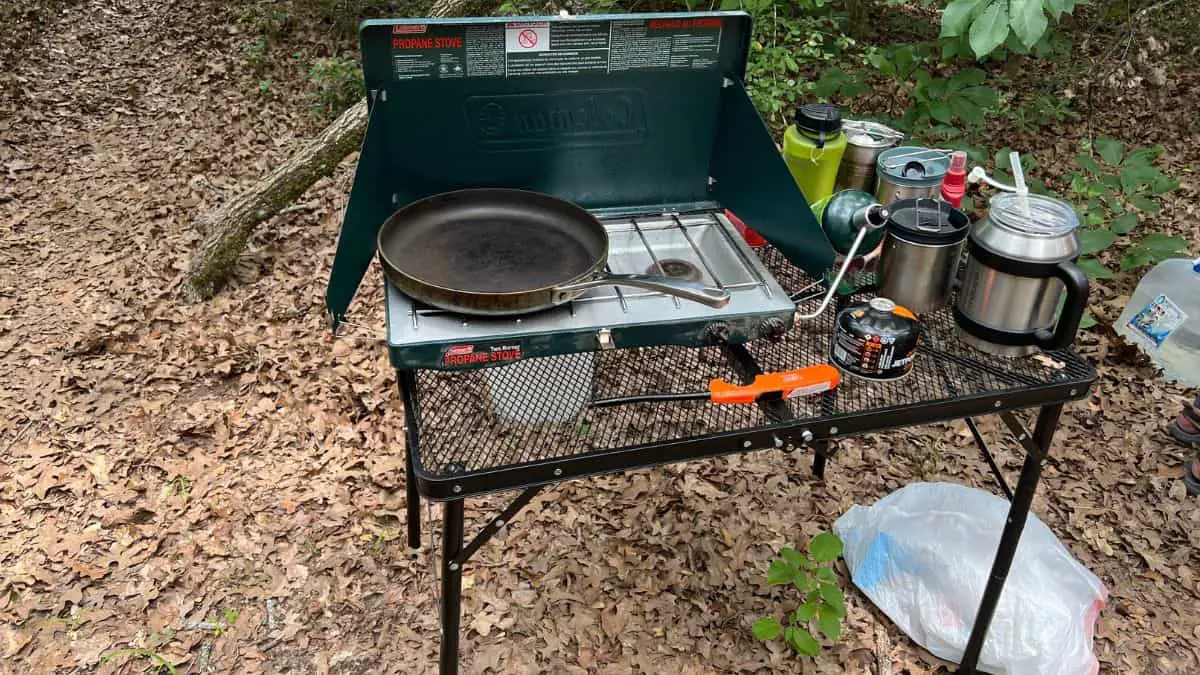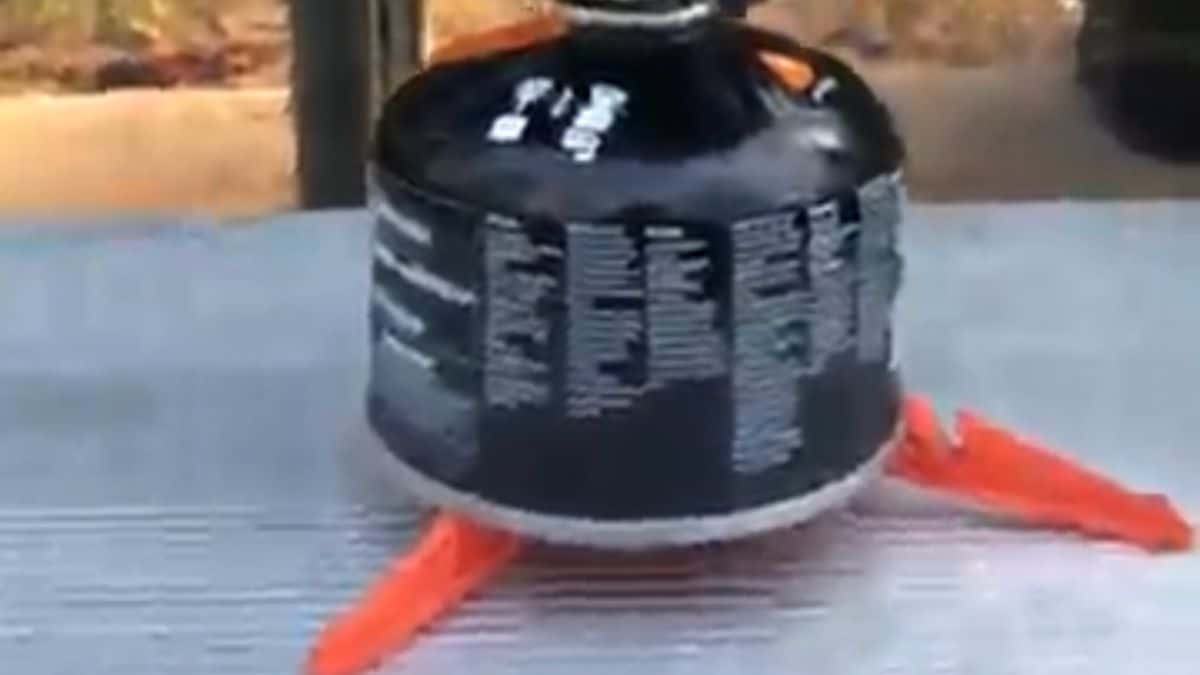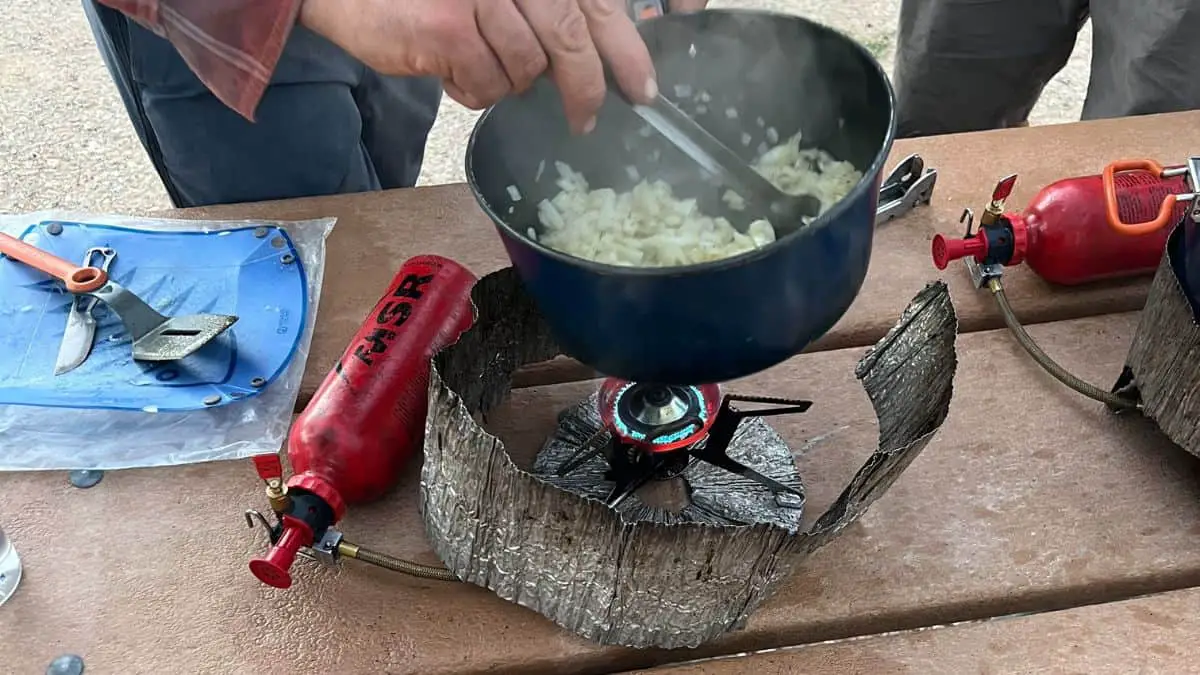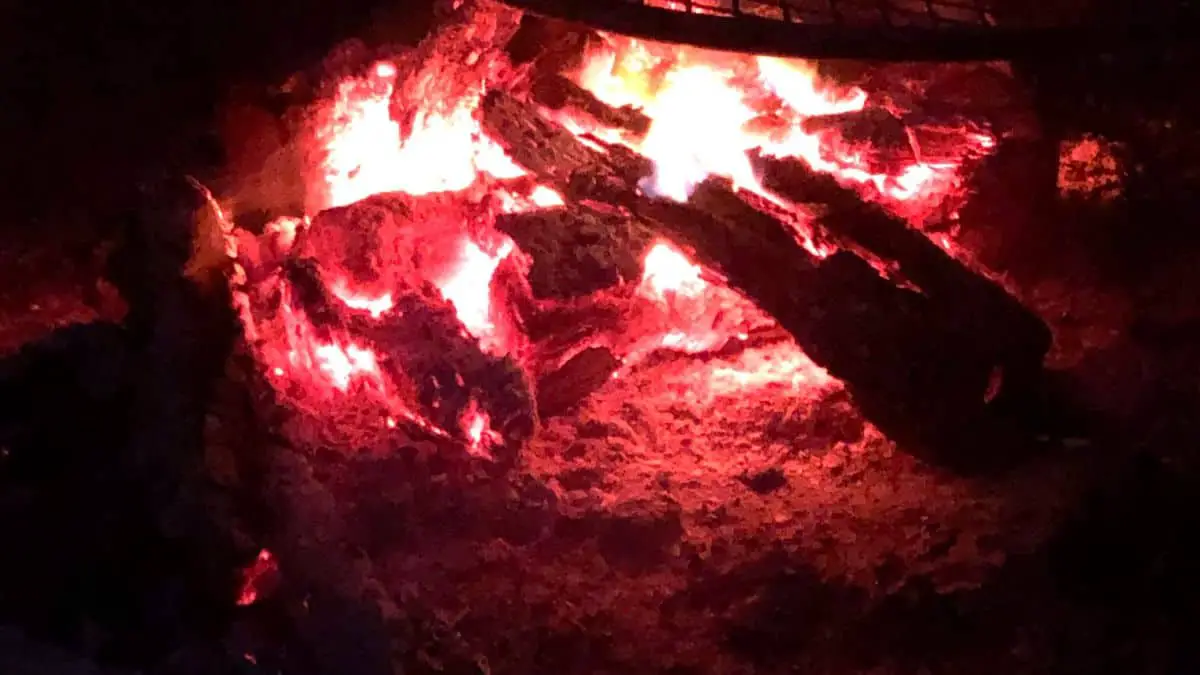Choose The Best Camping Fuel For Backpacking And Car Camping
If you click and purchase with one of our links, we earn a commission. Thanks.

Use fuel canisters when camping. It is cheaper, portable, and safer to use. The exception would be for high altitude or extreme cold where you will need a liquid fuel stove. Liquid fuel requires more care to operate safely. Wood stoves are sufficient in areas with plenty of firewood.
Key Takeaways:
- Choosing the right camping stove fuel is crucial for efficient cooking during your outdoor adventures.
- Consider factors such as weight, convenience, availability, and performance when selecting a fuel type.
- Canister fuel, liquid fuel, denatured alcohol, and wood are common camping stove fuel options.
- Canister fuel is lightweight and easy to use but may not perform well in cold weather.
- Liquid fuel is more efficient for longer trips but requires priming and careful handling.
Main Types of Camping Stoves
When it comes to choosing a camping stove for your outdoor adventures, it’s important to consider the different types available. Depending on whether you’re backpacking or car camping, there are specific stoves designed to meet your needs. Let’s take a closer look at the main types of camping stoves: backpacking stoves and car camping stoves.
Backpacking Stoves
Backpacking stoves are specifically designed for lightweight and compactness, making them ideal for hikers and backpackers who prioritize portability. These stoves are typically small in size and use lightweight fuel canisters to provide efficient cooking power. They are easy to set up and pack away, allowing you to save space in your backpack for other essential gear. I also like to use my backpacking stove even on car camping trips to make coffee. In particular, on group trips where I can enjoy the time to myself next to my tent or because it’s raining and I don’t want to leave my vestibule.
Car Camping Stoves
On the other hand, car camping stoves offer more cooking power and convenience. These stoves are larger in size and often feature multiple burners, allowing you to cook multiple dishes at once. Car camping stoves are typically fueled by propane or butane canisters, which provide a steady and reliable source of heat for your cooking needs. They are perfect for campers who prefer to set up a base camp and have access to a vehicle to transport their gear.
Whether you’re embarking on a backpacking adventure or planning a car camping trip, choosing the right type of stove is crucial. Consider your specific needs and preferences to determine which type of camping stove will best suit your outdoor cooking requirements.
Table: Comparison of Backpacking Stoves and Car Camping Stoves
| Aspect | Backpacking Stoves | Car Camping Stoves |
|---|---|---|
| Portability | Compact and lightweight | Larger size, less portable |
| Cooking Power | Less powerful | More powerful |
| Number of Burners | Usually single burner | Multiple burners |
| Fuel Type | Fuel canisters (propane or butane) | Fuel canisters (propane or butane) |
| Setup and Pack Away | Quick and easy | Requires more space and time |
Canister Fuel

Canister fuel is a popular choice for camping stoves, offering a convenient and efficient solution for outdoor cooking. The canister is typically filled with a mixture of butane and propane or isobutane and propane, making it lightweight and easy to use. The pressurized canister allows for quick ignition and precise flame control, ensuring a reliable cooking experience.
One of the key advantages of canister fuel is its portability. The compact size and lightweight nature of the canister make it ideal for backpacking and other outdoor activities where space and weight are limited. Additionally, canister fuel stoves are highly responsive, providing instant heat when you need it. This makes them a popular choice for hikers and campers who value efficiency and convenience.
When using a canister stove, it’s important to ensure proper ventilation to prevent any buildup of potentially harmful gases. Always follow the manufacturer’s instructions for safe and efficient use. Canister fuel is widely available and can be purchased at camping supply stores, outdoor retailers, and even online. Consider the size and duration of your camping trip when selecting the appropriate canister size, as well as the expected temperature conditions to ensure optimal performance.
Comparison Table: Canister Fuel vs. Other Fuel Types
| Canister Fuel | Liquid Fuel | Denatured Alcohol | Wood | |
|---|---|---|---|---|
| Portability | High | Medium | High | Low |
| Ignition | Quick | Requires priming | Quick | Requires fire-starting |
| Availability | Widely available | Available, but less common | Available, but less common | Dependent on location |
| Temperature Performance | May lose pressure in cold weather | Can be repressurized, better for cold weather | Burns well in various temperatures | Dependent on firewood availability |
| Convenience | Easy to use, no priming required | Requires priming | Easy to use, no priming required | Requires fire-starting and preparation |
Pros and Cons of Canister Fuel
Canister fuel is a popular choice for camping stoves due to its convenience and efficiency. Here are some pros and cons to consider:
Pros:
-
Lightweight and Compact: Canister fuel is incredibly portable, making it ideal for backpacking and other outdoor activities where space and weight are a concern. A single canister can provide enough fuel for several meals.
-
Easy to Use: Canister stoves are simple to operate, requiring minimal setup and maintenance. Most canisters come with a built-in valve system that allows for easy control of the flame.
Cons:
-
Cost: Canister fuel can be more expensive compared to other fuel types, especially when considering the cost per unit of energy. This can add up, especially for longer camping trips.
-
Waste: Canisters are typically disposable, which means they contribute to waste. While some companies offer recycling programs, not all areas have convenient recycling options.
-
Cold Weather Performance: Canister fuel may not perform as well in extremely cold temperatures. The pressure in the canister can be affected, resulting in decreased efficiency and slower cooking times.
Table: Pros and Cons of Canister Fuel
| Pros | Cons |
|---|---|
| Lightweight and compact | Cost |
| Easy to use | Waste |
| Cold weather performance |
When it comes to choosing and using canister fuel for your camping stove, there are a few important considerations to keep in mind. These tips will help you make an informed decision and ensure optimal performance during your outdoor adventures.
Choosing the Right Canister Fuel
When buying canister fuel, it’s essential to consider the temperature conditions of your camping trip. Different fuel mixes perform better in specific weather conditions. For example, isobutane-propane mixes are more suitable for cold weather camping, while butane-propane mixes work well in warmer temperatures.
It’s important to check the fuel label for the recommended temperature range. Look for canister fuel that is specifically designed for the climate you’ll be camping in to ensure efficient cooking performance.
Maximizing Efficiency
To maximize the efficiency of your canister fuel, it’s helpful to warm the canister before use in cold weather. One way to do this is by storing the canister in your jacket pocket or sleeping bag overnight. This will help maintain pressure and increase fuel vaporization, leading to better cooking performance.
Additionally, always pack a spare canister of fuel to avoid running out during your camping trip. It’s better to have more fuel than you think you’ll need, especially if you’re planning to cook multiple meals or boil water frequently.
Proper Storage and Safety
When storing canister fuel, it’s crucial to keep it in a well-ventilated area away from direct sunlight, open flames, and sources of heat. Make sure the canister is tightly sealed to prevent leaks. Proper storage will help maintain the fuel’s quality and prevent any potential safety hazards.
When using canister fuel, always follow the manufacturer’s instructions for your specific camping stove model. Be sure to read and understand the safety precautions outlined in the user manual. This will help ensure a safe and enjoyable camping experience.
| Pros of Canister Fuel | Cons of Canister Fuel |
|---|---|
| Lightweight and easy to use | Can be more expensive than other fuel types |
| Provides efficient cooking power | Creates more waste |
| Works well in warm weather | May not perform well in cold weather |
Liquid Fuel

Liquid fuel is another option for camping stoves, offering versatility and reliability for your outdoor cooking needs. With liquid fuel stoves, you have the flexibility to choose from a range of fuel types, including white gas, kerosene, diesel, and even automotive gas. These stoves require filling and pressurizing canisters on your own, providing you with greater control over your fuel supply.
White gas is a popular choice for liquid fuel stoves. It burns clean and efficiently, making it ideal for longer camping trips. It is also widely available, ensuring that you can find fuel for your stove easily. Kerosene and diesel are alternative options that may be more readily available in specific locations. While they may not burn as cleanly as white gas, they can still provide reliable performance.
When using a liquid fuel stove, it’s important to follow proper safety procedures and priming techniques. Priming the stove should be done carefully to avoid waste and potential fire hazards. Additionally, packing a liquid fuel stove may be a bit more challenging due to the fuel lines, but the benefits of longer trip durations and the ability to repressurize in cold temperatures make it a worthwhile choice for many outdoor enthusiasts.
Table: Comparison of Liquid Fuel Types
| Fuel Type | Advantages | Disadvantages |
|---|---|---|
| White Gas | Burns clean and efficiently | May not be as readily available in certain locations |
| Kerosene | Widely available | May not burn as cleanly as white gas |
| Diesel | Readily available | May not burn as cleanly as white gas |
| Automotive Gas | May be available in emergency situations | Not as commonly used or recommended |
Main Types of Camping Stoves
When it comes to camping stoves, there are two main types to consider: canister fuel stoves and liquid fuel stoves. Each has its pros and cons, so it’s important to understand what they offer before making a decision.
Canister Fuel Stoves
Canister fuel stoves are popular among backpackers and campers due to their convenience and ease of use. These stoves use pressurized canisters that typically contain a mix of butane and propane or isobutane and propane.
One of the main advantages of canister fuel stoves is their portability. They are lightweight and compact, making them ideal for backpacking trips. Canister fuel stoves also provide efficient cooking power, allowing you to boil water and cook meals quickly.
Liquid Fuel Stoves
Liquid fuel stoves, on the other hand, offer a different set of benefits. These stoves require filling and pressurizing fuel canisters on your own, typically with fuels such as white gas, kerosene, diesel, or automotive gas.
One of the main advantages of liquid fuel stoves is their versatility. They can be fueled by various types of liquid fuel, making them a reliable option in different locations and situations. They are also more efficient for longer trips and can be repressurized in cold temperatures.
Pros and Cons
| Canister Fuel Stoves | Liquid Fuel Stoves | |
|---|---|---|
| Pros | Lightweight and compact | Versatile fuel options |
| Easy to use | More efficient for longer trips | |
| Provides efficient cooking power | Can be repressurized in cold temperatures | |
| Cons | More expensive | Priming required |
| Creates more waste | Fuel lines make packing more challenging |
Ultimately, the choice between canister fuel stoves and liquid fuel stoves comes down to your specific needs and preferences. Consider factors such as portability, versatility, and temperature conditions when deciding which type of camping stove fuel is right for you.
Buying and Use Tips for Liquid Fuel
When it comes to camping stoves, liquid fuel offers a versatile and reliable option for outdoor cooking. Before purchasing liquid fuel for your stove, there are a few important factors to consider. Understanding the different types of liquid fuel available, as well as how to properly use and maintain your stove, can make all the difference in ensuring a successful camping trip.
Types of Liquid Fuel
There are various types of liquid fuel that can be used with camping stoves, each with its own advantages and considerations. Here are some common options:
| Fuel Type | Description |
|---|---|
| White Gas | A clean-burning and widely available fuel that provides excellent performance in most camping conditions. It is commonly used in backpacking and camping stoves. |
| Kerosene | An alternative to white gas, kerosene is readily available in many parts of the world. It works well in extreme cold temperatures and offers good efficiency. |
| Diesel | Although not as common as white gas or kerosene, diesel can be used as a fuel option for camping stoves. It is easily accessible and provides reliable performance. |
Before purchasing a specific type of liquid fuel, check your stove’s manufacturer guidelines to ensure compatibility with the fuel you choose.
Using Liquid Fuel Safely
When using liquid fuel with your camping stove, it’s important to follow proper safety procedures. Here are some tips to keep in mind:
Always operate your stove in a well-ventilated area to avoid carbon monoxide buildup. Do not overfill your fuel canister. Fill it to the recommended level indicated by the manufacturer. Prime your stove before use, following the instructions provided in the stove’s manual. Store your liquid fuel canisters in a safe and secure location, away from heat sources and open flames. Regularly inspect your stove and fuel canisters for any signs of damage or leaks. If you notice any issues, replace them immediately. By following these buying and use tips for liquid fuel, you can ensure a safe and enjoyable camping experience. Remember to always prioritize safety and carefully read and follow the instructions provided by the stove and fuel manufacturers.
Other Fuel Options

While canister and liquid fuel are popular choices for camping stoves, there are other options available that may suit your needs. Two alternative fuel options to consider are denatured alcohol and wood.
Denatured Alcohol
Denatured alcohol is an affordable and widely available option for camping stoves. It is a clean-burning fuel that can be stored in lightweight bottles, making it convenient for backpacking and car camping alike. Denatured alcohol burns efficiently, producing a steady flame that allows for effective cooking. It is less volatile than other fuel types, reducing the risk of accidents and spills. However, it is important to note that denatured alcohol may not provide the same level of heat output as other fuel types, so you may need to adjust your cooking time accordingly.
Wood as Fuel
In certain situations, wood can be used as a fuel source for camping stoves. It is a natural and readily available option, especially when camping in areas with ample wood resources. Using wood as fuel can add a rustic touch to your outdoor cooking experience. However, it is important to check local regulations and restrictions on wood fires before using this fuel type. Additionally, wood may not be as convenient as other fuel options, as it requires collecting, chopping, and drying the wood before use. It also produces more smoke and can leave behind residue on your stove. Therefore, it is essential to clean and maintain your stove regularly when using wood as fuel.
| Fuel Type | Advantages | Disadvantages |
|---|---|---|
| Denatured Alcohol | Affordable and widely available | Lower heat output, longer cooking time |
| Wood | Natural and readily available | Requires collection and preparation, produces smoke and residue |
Factors to Consider for Choosing Camping Fuel
When planning your outdoor adventures, choosing the right camping fuel is essential for efficient cooking. Consider the following factors to make an informed decision that suits your needs:
1. Itinerary
Take into account the duration and location of your camping trip. If you are embarking on a multi-day backpacking journey, lightweight fuel options like canister fuel or denatured alcohol may be more suitable. For car camping trips with a fixed base, you have the flexibility to opt for liquid fuel or even wood, depending on availability and regulations. Professional guides prefer to use liquid fuel stoves because they are simpler to fix in the field and will work in any environment though the fuel is much heavier.
2. Meal Plan
Consider the type of meals you’ll be preparing. If you require quick and high heat for boiling water or cooking simple meals, canister fuel with its instant ignition and efficient performance might be your best bet. On the other hand, if you plan on cooking elaborate meals that require precise temperature control, liquid fuel stoves provide more versatility.
3. Personal Preferences
Think about what matters most to you as a camper. Are you looking for convenience and ease of use, or are you willing to put in some extra effort for a more traditional experience? Canister fuel offers a hassle-free setup and clean burning, while liquid fuel stoves can be more hands-on but provide a satisfying sense of self-sufficiency.
4. Weight and Convenience
Consider the weight and portability of the fuel options. Canister fuel is lightweight and comes in compact canisters, making it ideal for backpackers. Liquid fuel, on the other hand, requires carrying a larger fuel bottle and can be bulkier. Evaluate the trade-offs between weight and convenience based on your specific needs.
5. Availability and Performance
Research the availability of different fuel types in the areas you plan to camp. Canister fuel is widely accessible and can be found in outdoor stores and even local supermarkets. Liquid fuel, such as white gas, may be less common but has a longer shelf life and can perform well in extreme conditions.
| Fuel Type | Weight | Convenience | Availability |
|---|---|---|---|
| Canister Fuel | Lightweight | Easy to use | Widely available |
| Liquid Fuel | Slightly heavier | Requires priming | May be location-dependent |
| Denatured Alcohol | Lightweight | Simple setup | Accessible in most areas |
| Wood | Variable | Requires gathering and preparation | Dependent on local regulations |
By carefully considering these factors, you can make an informed decision when it comes to choosing the right camping fuel. Remember to prioritize your specific needs and preferences to enhance your outdoor cooking experience.
Temperature Control
When camping in cold weather, temperature control is essential for efficient cooking. Different fuel types can have varying performance in low temperatures, so it’s important to choose the right one for your needs. Canister fuel, which is a popular option for camping stoves, can lose pressure and become less effective in colder conditions. On the other hand, liquid fuel stoves can be repressurized and provide reliable temperature control even in low temperatures.
Canister fuel can be convenient for camping trips in warmer climates, but if you plan to cook in colder weather, a liquid fuel stove may be a better choice. Liquid fuel stoves, such as those that run on white gas or kerosene, can be primed and adjusted to deliver consistent heat, making them more reliable in cold temperatures.
Table: Comparison of Temperature Control for Different Camping Stove Fuels
| Fuel Type | Performance in Cold Weather |
|---|---|
| Canister Fuel | May lose pressure and become less effective |
| Liquid Fuel | Can be repressurized and deliver consistent heat |
High Altitude Considerations
When planning your camping trip to high altitudes, it’s important to consider the impact it can have on your camping stove’s performance. At higher elevations, the air is thinner, which can affect the efficiency of certain fuel types.
Canister fuel, for example, may struggle to maintain its pressure at higher altitudes, resulting in slower cooking times and reduced heat output. If you’re camping at high altitudes, it’s advisable to opt for a liquid fuel stove that is specifically designed for such conditions. These stoves can still perform effectively, allowing you to cook your meals with ease.
FAQ
What are the main types of camping stoves?
The main types of camping stoves are backpacking stoves and car camping stoves.
What is canister fuel?
Canister fuel is a lightweight and pressurized fuel option for camping stoves, typically containing a mix of butane and propane or isobutane and propane.
What are the pros and cons of canister fuel?
The pros of canister fuel include being lightweight and easy to use, while the cons include being more expensive and potentially performing poorly in cold weather.
What should I consider when buying and using canister fuel?
When buying canister fuel, consider the temperature conditions of your camping trip and choose the appropriate mix of fuel. To use canister fuel in cold weather, warm the canister in your jacket before use.
What is liquid fuel?
Liquid fuel is another option for camping stoves that requires filling and pressurizing canisters. Different types of liquid fuel, such as white gas, kerosene, diesel, and automotive gas, can be used.
What are the pros and cons of liquid fuel?
The pros of liquid fuel include being more efficient for longer trips and being able to be repressurized in cold temperatures. The cons include needing priming and being more challenging to pack due to fuel lines.
What should I consider when buying and using liquid fuel?
When buying liquid fuel, ensure your stove can run on multiple types of fuel. Different types of fuel have their own advantages, such as white gas being widely available and kerosene and diesel being easier to find in specific locations. Priming the stove should be done carefully to avoid waste and fire hazards.
What are the other fuel options for camping stoves?
Other fuel options include denatured alcohol and wood. Denatured alcohol is affordable and burns clean, while wood can be used as fuel in certain situations but may not be allowed in certain areas.
What factors should I consider when choosing camping fuel?
When choosing camping fuel, consider factors such as your itinerary, meal plan, and personal preferences. Evaluate the weight, convenience, availability, and performance of different fuel types.
How can I ensure temperature control when using camping stoves?
Different fuel types can have varying performance in cold weather. Canister fuel may lose pressure, while liquid fuel can be repressurized. Consider the temperature conditions of your camping trip and choose a fuel type that can provide reliable temperature control.
What considerations should I keep in mind when camping at high altitudes?
High altitudes can affect the performance of camping stoves. Canister fuel may not function as well, while certain liquid fuel stoves designed for high altitudes can still perform effectively. Consider the altitude of your camping destination and choose a fuel type that is suitable for high-altitude cooking.